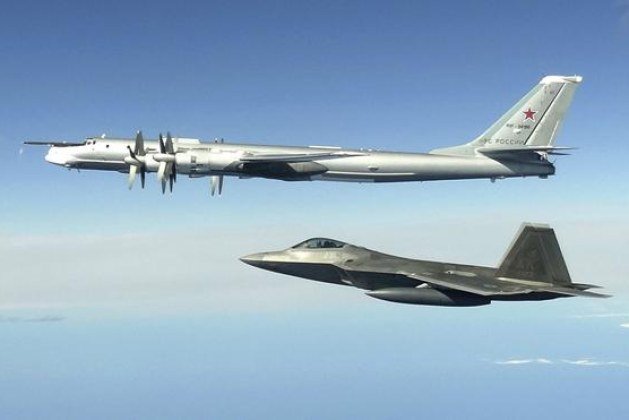This week, the United States and Canada successfully intercepted two Chinese bombers and two Russian bombers that were operating within international airspace near the US state of Alaska.
This interception marks a significant moment as it is the first recorded instance of Russian and Chinese bombers flying together over the North Pacific, highlighting a growing trend in military collaboration that has sparked concerns among the United States and its allies.
The North American Aerospace Defense Command managed to intercept two Russian and two Chinese bombers near Alaska on Wednesday, signaling a momentous occasion as it was the first time these two nations were caught operating together.
The bombers remained within the airspace of Alaska’s Air Defense Identification Zone (ADIZ) and were not perceived as a threat, according to a statement issued by NORAD.
The interception involved Russian TU-95 Bear and Chinese H-6 bombers, which have not previously ventured into the Alaska ADIZ, as per a statement from NORAD.
This event also signifies the first time Chinese H-6 bombers, which evolved from older Soviet bombers, have ventured into the airspace of Alaska.
Read Article: Roger Marshall Becomes First US Senator to Walk from Controversial Crypto
The operation was conducted by U.S. F-16 and F-35 fighter jets, alongside Canadian CF-18 fighters, with additional support from other aircraft.
On Thursday, China’s Defense Ministry confirmed that the Chinese and Russian air forces had come together for a “joint strategic aerial patrol in the relevant airspace of the Bering Sea” as part of their ongoing annual cooperation plan.
Zhang Xiaogang, the spokesperson for the Chinese Defense Ministry, disclosed that this was the eighth such patrol in the eight-year history of such cooperation, which is aimed at enhancing the level of cooperation between the two air forces and deepening strategic mutual trust and practical cooperation among the two nations.
Zhang emphasized that the operation was not directed against any third parties and was compliant with international laws and practices. It was also stressed that the exercise had no connection to current global or regional scenarios.
The Russian Defense Ministry affirmed that the joint patrol conducted over the North Pacific Ocean, including the narrow Bering Strait separating eastern Russia from Alaska.
Read Article: South Korea’s new crypto law, the Virtual Asset User Protection Act (VAUPA), has started
Both Russian and Chinese crews addressed issues related to cooperation throughout the patrol, which spanned over five hours and saw the participation of Russian Su-30SM and Su-35S fighter jets as well.
A video released by the Russian Defense Ministry shows the collaboration between the bombers and the interception by U.S. and Canadian aircraft.
Russia clarified that this exercise was a part of the 2024 military cooperation plan and was not aimed at targeting any third parties.
Read Article: Significant Changes Hidden Under the Surface in a New Trump-Harris Survey
On Thursday, when inquired about whether the interception of Russian and Chinese aircraft could be interpreted as a form of “testing” by Russia and China in response to President Joe Biden’s decision to withdraw from the 2024 presidential race, Defense Secretary Lloyd Austin affirmed that “Russia and China are always testing us.”
“As to whether our adversaries are testing us at this particular time, they are always testing us, and that’s no surprise to any of us,” he stated during a press conference at the Pentagon.
Austin clarified that the presence of Russian and Chinese aircraft approaching US airspace was not unexpected. “We closely monitored these aircraft, tracked the aircraft, intercepted the aircraft, which demonstrates that … our forces are at the ready all the time, and we have very good surveillance capabilities,” he elaborated.
He further mentioned that the “closest point of approach” of the Russian and Chinese aircraft to the US was approximately 200 miles off the coast. “If there’s any kind of challenge from any direction, I have every confidence that NORTHCOM and NORAD will be at the ready and will be able to intercept,” he added.
Read More: Avacoin Token Listing Date 2024: Get Ready to Explore!
Austin also reiterated the US’s concerns regarding the growing relationship between Russia and China, primarily due to worries about China’s support for Russia’s illegal and unnecessary war in Ukraine. “We’ll see what happens and how this relationship continues to develop,” he stated.
It is worth noting that Russian flights into Alaska’s Air Defense Zone are not uncommon. In May, Russia conducted four flights into Alaska’s Air Defense Zone, which NORAD described as a “regular occurrence.”
However, the involvement of Chinese aircraft in this context appears to be a recent development. In March, the head of US Northern Command, General Gregory Guillot, expressed his expectation of seeing Chinese aircraft in the Arctic as early as this year, noting their “willingness and desire to act up there.”
“We have seen them in the maritime. We have seen them under the cloud of a technical or scientific research, but we think it is certainly multi-mission, to include military. And then I expect to see air activity in the Alaska part of the Arctic as soon as this year, potentially,” he stated.
“It is a very big concern of mine.”
China views itself as a “near-Arctic” state and has been working to expand its presence in the far north, including through its collaboration with Russia.
“Alaska continues to be on the frontlines of the authoritarian aggression by the dictators in Russia and China who are increasingly working together,” said Sen. Dan Sullivan in a statement. The Alaska Republican cautioned that “these kinds of joint Russia and China incursions on the sea and in the air near Alaska will continue.”




